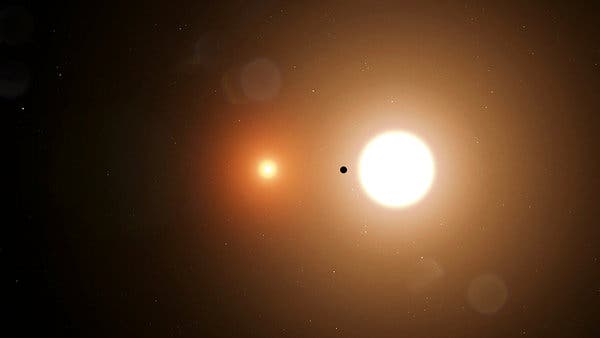The summer before senior year of high school can be a stressful time for a teenager. Childhood is winding down. College applications loom large. Many students are looking for an edge that will help them get into the right school. Last year, Wolf Cukier, 17, spent his summer vacation as few other rising seniors have: He helped discover a planet.
Meet TOI 1338 b, the newly identified world orbiting two stars more than 1,300 light years away.
Last July, just after he finished his junior year at Scarsdale High School in Scarsdale, N.Y., Wolf started an internship at NASA’s Goddard Space Flight Center in Greenbelt, Md. His job was to scrutinize data that had been beamed back from outer space by TESS, or the Transiting Exoplanet Survey Satellite.
A unique aspect of the TESS project is that it invites regular people to volunteer to watch the online transmission for patterns in star brightness that might suggest the existence of a new planet, a sort of crowdsourcing of the universe. (Read more here about TESS and the scores of alien worlds it has found.)
During the first week of the internship, as he sifted through data that had been flagged by citizen-scientists, he zeroed in on a system that included two orbiting stars. He identified a body in that system that was later verified as a planet about 6.9 times as large as Earth. His colleagues gave the system a name, TOI 1338, an acronym for TESS Object of Interest, and then called the planet TOI 1338 b.
“It was awesome,” Wolf said in an interview on Friday. “I never expected to find anything. The fact that I found something is cool, and seeing the scientific process and how many people have to work to verify the planet, and techniques for things like that, it is awesome.”
[Sign up to get reminders for space and astronomy events on your calendar.]
Wolf had come a long way from peering through the telescope in his room at home in Scarsdale, where light pollution has made it difficult to detect stars.
On Monday, scientists involved with the TESS project announced the verification at the American Astronomical Society in Honolulu. It is the first time that the TESS project has discovered a circumbinary planet, which is a planet orbiting two stars, since the two-year program was started in April 2018, a NASA statement said.
So far, TOI 1338 b is the only known planet in the system. While NASA’s Kepler and K2 missions have previously discovered 12 circumbinary planets, many more of them are expected to be discovered by TESS, the NASA statement said.
There is inarguably plenty of space out there to do so.
“Throughout all of its images, TESS is monitoring millions of stars,” said Adina Feinstein, a graduate student at the University of Chicago who was a co-author of the research paper, in the statement.
TESS’s four cameras, which each capture an image of a patch of sky every 30 minutes, enable scientists to make graphs of changes in the brightness of stars.
Any dip in the brightness of a single star is a good indication that a planet has crossed in front of it. But TOI 1338 b was particularly elusive because it involved two stars — a large star where the planet’s transit was easy to detect, and a smaller one where the planet’s transit was so small it was not observable.
That was where Wolf came in. He initially thought the transit that was later identified as belonging to TOI 1338 b was the smaller star passing in front of the larger one. But the timing seemed off for an eclipse, and Wolf suspected there might be the existence of a planet.
The human eye is extremely good at finding such patterns in data, said Veselin Kostov, Wolf’s mentor and a research scientist at the SETI Institute and Goddard.
“These are the types of signals that algorithms really struggle with,” he said in the statement.
Wolf consulted on his find with his mentor, and a verification process began using archival data from earlier surveys of the system that later became known as TOI 1338. The scientists also enlisted a software package called eleanor — named after Eleanor Arroway, the central character in Carl Sagan’s novel “Contact” — to confirm the transits were real and not a result of instrumental artifacts, the statement said.
Wolf plans to study astrophysics when he starts college in September, he said (he hasn’t decided where just yet). He said he was humbled by his contribution to the discovery of the new world, emphasizing the team work in the verification process.
“We identified a promising candidate,” he said. “You can’t be arrogant. It is a planet, insofar as we can claim any other exoplanet, pretty much.”
Has he bragged much about the discovery? Not really.
It “just doesn’t come up in small talk,” he said.








